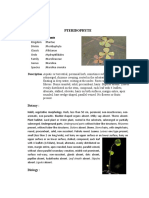Professional Documents
Culture Documents
Polytrichum Commune Var. Commune
Uploaded by
Tanasa GabrielaOriginal Description:
Original Title
Copyright
Available Formats
Share this document
Did you find this document useful?
Is this content inappropriate?
Report this DocumentCopyright:
Available Formats
Polytrichum Commune Var. Commune
Uploaded by
Tanasa GabrielaCopyright:
Available Formats
Polytrichales
Polytrichum commune var. commune
P. uliginosum
Common Haircap Key 95
4-angled, box-like capsule
2 cm
Constriction
4 cm 2 cm 5 mm
Identification Well-grown, large, hummocks or turfs of this species are unmistakable. They consist of
tough, wiry shoots up to 40 cm long (usually about 20 cm). When moist, the 8–12 mm
long, narrowly spearhead-shaped leaves spread or strongly curve away from the stem,
with a glossy sheathing base, giving a starry appearance viewed from above. When dry,
the margins become inrolled, wavy and gently twist around the stems. The margins
are sharply toothed and the broad nerve is covered with up to 70 ridges of tissue.
The leaves surrounding the base of the seta are longly tapering and toothed above.
The 4-angled, box-like capsule, produced in summer, is borne on a long (to 12 cm),
reddish seta. It is erect when young, becoming inclined to horizontal with age; its lid is
shortly beaked. The young capsule is covered by a long, golden brown, hairy calyptra.
Similar species It can be distinguished from the usually shorter var. perigoniale (p. 323) and var.
humile (Smith, p. 129), both plants of drier ground, by its more strongly toothed, evenly
tapering leaves surrounding the base of the seta. Polytrichastrum formosum (p. 320)
is also a shorter plant of drier, usually more shaded habitats; its sheathing leaf base is
less glossy and the leaves are a little broader. The 5- to 6-angled capsule with a longer
beak and a base that is not separated from the capsule by a constriction, borne on
a shorter seta distinguishes P. formosum, but often (especially with plants from wet
heaths) microscopical examination of a leaf section is necessary. However, the back of
a moist, fully developed leaf of P. formosum may have a V-shaped ridge formed by the
back of the nerve, whereas the back of a P. commune leaf is rounded.
Habitat Found in a wide range of damp, acidic habitats, tolerating shade and moderate
amounts of pollution and nutrient enrichment. It often abounds on wet moors in the
uplands, but is also frequent throughout western, lowland Britain in wet woodlands,
bogs, ditches, by lake margins, on heaths, etc. In the drier south-east it is perhaps
most frequent in old gravel pits and sand pits by pools under willow and birch scrub.
322 Photos Sean Edwards (left), Des Callaghan (top right), Gordon Rothero (bottom centre) &
David Genney (bottom right) Text Fred Rumsey
You might also like
- PterisDocument19 pagesPterisYashica LalNo ratings yet
- Kumpulan DeskriptorDocument3 pagesKumpulan DeskriptorDaus SaifurrohmanNo ratings yet
- Observations enDocument21 pagesObservations enramongonzaNo ratings yet
- Morchella. Crassipes The Irregular Pits andDocument6 pagesMorchella. Crassipes The Irregular Pits andValentina CretuNo ratings yet
- The Flora of British IndiaDocument725 pagesThe Flora of British IndiaPradeepa SerasingheNo ratings yet
- Leon 1919Document3 pagesLeon 1919georgesidneybarachoNo ratings yet
- Panicum Capillare Adalah Spesies Tumbuhan Yang Tergolong Ke Dalam Famili Poaceae. SpesiesDocument4 pagesPanicum Capillare Adalah Spesies Tumbuhan Yang Tergolong Ke Dalam Famili Poaceae. Spesiesroy gunawanNo ratings yet
- Sugar Cane Morphology - ProjectDocument6 pagesSugar Cane Morphology - Projectsulha mNo ratings yet
- DICRANACEAE Schimper: Robert R. Ireland JRDocument15 pagesDICRANACEAE Schimper: Robert R. Ireland JRCristopher Jimenez OrozcoNo ratings yet
- FISSIDENTACEAE Schimper: Ronald A. PursellDocument13 pagesFISSIDENTACEAE Schimper: Ronald A. PursellCristopher Jimenez OrozcoNo ratings yet
- Hardwood Cuttings And-Live-Stakes PDFDocument3 pagesHardwood Cuttings And-Live-Stakes PDFdanNo ratings yet
- Flora of China Volume 19 CaprifoliaceaeDocument26 pagesFlora of China Volume 19 CaprifoliaceaeAnantha Krishna K SNo ratings yet
- Botany TerminologyDocument96 pagesBotany TerminologySashka Toncheva100% (2)
- Flora of China - Key To DendrobiumDocument32 pagesFlora of China - Key To Dendrobiumfelinabranca100% (1)
- Classification of MossesDocument32 pagesClassification of MossesMuthiaranifs86% (7)
- Vol28 Bry RoelDocument72 pagesVol28 Bry RoelCristopher Jimenez OrozcoNo ratings yet
- Myrsinaceae. Flora of China. Vol. 15. 1996.Document38 pagesMyrsinaceae. Flora of China. Vol. 15. 1996.Dr. John PipolyNo ratings yet
- Gleason 1958 Panama Melastomataceae ANNMOBOTDocument103 pagesGleason 1958 Panama Melastomataceae ANNMOBOTorinocofriendsNo ratings yet
- Alcove Pond Assingment ScienceDocument7 pagesAlcove Pond Assingment ScienceJerolNo ratings yet
- Botany Lecture 1-7Document2 pagesBotany Lecture 1-7KlareDesteenTyNo ratings yet
- Reviewer Botany Lab - FINALS 1Document18 pagesReviewer Botany Lab - FINALS 1Ordinary GuitaristNo ratings yet
- Marsilea Crenata: PteridophyteDocument9 pagesMarsilea Crenata: PteridophyteNur Rezki OctaviaNo ratings yet
- ACANTHACEAE - Flora Panama PDFDocument130 pagesACANTHACEAE - Flora Panama PDFJose GuerreroNo ratings yet
- Where To Find Magic MushroomsDocument11 pagesWhere To Find Magic MushroomsAimee Hoyt93% (14)
- Scientific All NameDocument5 pagesScientific All Nameleo AñascoNo ratings yet
- Botany HorsetailDocument3 pagesBotany HorsetailJohn Kevin NocheNo ratings yet
- Green 2002Document51 pagesGreen 2002ΑΝΑΣΤΑΣΙΑ ΝΕΡΑΝΤΖΗNo ratings yet
- R I S E: Esearch Nformation Eries On CosystemsDocument52 pagesR I S E: Esearch Nformation Eries On CosystemsBernadette SanchezNo ratings yet
- Sphagnum Fallax: Flat-Topped Bog-MossDocument1 pageSphagnum Fallax: Flat-Topped Bog-MossJorge DanielNo ratings yet
- Flora of SurinameDocument97 pagesFlora of SurinameMolineNo ratings yet
- Gymnosperm and AngiospermDocument6 pagesGymnosperm and AngiospermAJNo ratings yet
- Capsicum Pubescens-The Rocoto PepperDocument3 pagesCapsicum Pubescens-The Rocoto Peppertizio caioNo ratings yet
- 1554Document198 pages1554grjhbNo ratings yet
- Evergreens by ZoneDocument4 pagesEvergreens by ZonejhNo ratings yet
- Common Ferns of Florida - E. Revuelta 2016bDocument38 pagesCommon Ferns of Florida - E. Revuelta 2016bAllan EPNo ratings yet
- Flora of China - RungiaDocument6 pagesFlora of China - RungiaGia Lộc TrầnNo ratings yet
- Test Bank For How Humans Evolved 8th by BoydDocument22 pagesTest Bank For How Humans Evolved 8th by BoydTabithaWatsonwbrc100% (46)
- Moss ChartDocument7 pagesMoss ChartSamela SelimovicNo ratings yet
- Botany StemDocument36 pagesBotany Stemartadiel28No ratings yet
- BryophyteDocument71 pagesBryophyteSuci Hidayati Dwi LestariNo ratings yet
- MyristicaceaeDocument6 pagesMyristicaceaebiowellNo ratings yet
- Naturally Curious Day by Day: A Photographic Field Guide and Daily Visit to the Forests, Fields, and Wetlands of Eastern North AmericaFrom EverandNaturally Curious Day by Day: A Photographic Field Guide and Daily Visit to the Forests, Fields, and Wetlands of Eastern North AmericaNo ratings yet
- Distribution: Malvastrum Coromandelianum (L.) Garcke, Bonplandia 5: 295. 1857Document3 pagesDistribution: Malvastrum Coromandelianum (L.) Garcke, Bonplandia 5: 295. 1857AlecioNo ratings yet
- The Genus Morinda (Rubiaceae) in ThailandDocument9 pagesThe Genus Morinda (Rubiaceae) in ThailandTasnuba JahanNo ratings yet
- Floral Biology of Pearl MilletDocument12 pagesFloral Biology of Pearl MilletBhawani SinghNo ratings yet
- PTERISDocument12 pagesPTERISCHAITHRA SHETTY100% (1)
- Flora of British in 02 Hook RichDocument808 pagesFlora of British in 02 Hook Richsksingl350100% (1)
- Oxalis Del PERUDocument290 pagesOxalis Del PERUpanchofrancoNo ratings yet
- EtymologyDocument11 pagesEtymologyJonee SansomNo ratings yet
- The Christmas Book (PDFDrive) PDFDocument354 pagesThe Christmas Book (PDFDrive) PDFЖанна Смітюх100% (1)
- 2018full Plant Catalogue PDFDocument17 pages2018full Plant Catalogue PDFMarkNo ratings yet
- Ferns: Sami Ali 2.BADocument11 pagesFerns: Sami Ali 2.BASami Ali 123No ratings yet
- Narra Information PaperDocument2 pagesNarra Information PaperKhaelNo ratings yet
- Bentley and Trimen-Medicinal Plants Vol 2 1875Document412 pagesBentley and Trimen-Medicinal Plants Vol 2 1875RonLayton100% (1)
- An Account of Genus DebregeasiaDocument21 pagesAn Account of Genus DebregeasiaamitNo ratings yet
- Budawangia No. 14 May.13Document6 pagesBudawangia No. 14 May.13Peter PigottNo ratings yet
- Zingiberaceae PublishedDocument58 pagesZingiberaceae PublishedNguyễn Trần Anh KhoaNo ratings yet
- Pee Dee: National Wildlife Refuge Bird ListDocument12 pagesPee Dee: National Wildlife Refuge Bird ListSomaSorrowNo ratings yet
- Medieval Tent and PavilionDocument7 pagesMedieval Tent and PavilionCharmaineTantiNo ratings yet
- U1excerpt PDFDocument15 pagesU1excerpt PDFvhin84No ratings yet
- 11895.2021.SF-III, dt.19.08.2021Document2 pages11895.2021.SF-III, dt.19.08.2021RDMA WarangalNo ratings yet
- BrochureDocument2 pagesBrochureapi-317586157No ratings yet
- 10 Automatic Detection of Forest Disturbance by SatelliteDocument2 pages10 Automatic Detection of Forest Disturbance by SatelliteBăh ŢăraneeNo ratings yet
- Chapter 1 - Main Hydrological ConceptsDocument16 pagesChapter 1 - Main Hydrological ConceptsWhy Merah0% (1)
- July-August 2005 Mobile Bay Audubon Society NewslettersDocument8 pagesJuly-August 2005 Mobile Bay Audubon Society NewslettersMobile Bay Audubon SocietyNo ratings yet
- Street Tree MasterplanDocument46 pagesStreet Tree MasterplandianamarizaNo ratings yet
- Literature Review On Outdoor RecreationDocument10 pagesLiterature Review On Outdoor Recreationaflspbnyu100% (1)
- Environmental Law in The PhilippinesDocument6 pagesEnvironmental Law in The PhilippinesAmaranto, Renz Angelo LucesNo ratings yet
- Brgy. Taba Ao Mangrove Assessment Report DraftDocument8 pagesBrgy. Taba Ao Mangrove Assessment Report DraftJohn Lyndel AlolonNo ratings yet
- Forest in IndiaDocument2 pagesForest in IndiaDipankar KumarNo ratings yet
- World Heritage Sites in The PhilippinesDocument3 pagesWorld Heritage Sites in The PhilippinesSharmane SantiagoNo ratings yet
- Isaura MayetiDocument1 pageIsaura Mayetipenyaramiro8758No ratings yet
- GSTC Training Supporting Materials v4Document27 pagesGSTC Training Supporting Materials v4Cahya KusumaNo ratings yet
- Golden Opportunity in Ghana'': A Negotiation Case Study and AnalysisDocument17 pagesGolden Opportunity in Ghana'': A Negotiation Case Study and AnalysisKuldeep UpadhyayaNo ratings yet
- StrandedDocument5 pagesStrandedapi-322303922No ratings yet
- 09 Leed Case StudyDocument52 pages09 Leed Case Studymahesh579No ratings yet
- Environmental Problems of AravaliDocument236 pagesEnvironmental Problems of Aravalipj10_rulesNo ratings yet
- A Survey of The Butterfly Fauna of Jatun Sacha, Ecuador (Lepidoptera: Hesperioidea and Papilionoidea)Document19 pagesA Survey of The Butterfly Fauna of Jatun Sacha, Ecuador (Lepidoptera: Hesperioidea and Papilionoidea)Kellyta RodriguezNo ratings yet
- Tim R. New (Auth.) - Insect Conservation and Urban Environments-Springer International Publishing (2015)Document252 pagesTim R. New (Auth.) - Insect Conservation and Urban Environments-Springer International Publishing (2015)Rogerio CansiNo ratings yet
- Biodiversity Monitoring ReportDocument8 pagesBiodiversity Monitoring ReportMILLER J. VILLASNo ratings yet
- Lake Water Balance and Mass Balance: ObjectivesDocument15 pagesLake Water Balance and Mass Balance: ObjectivesJoko NugrohoNo ratings yet
- Monitoring of Land Use and Land Cover Changes in MT PulagDocument12 pagesMonitoring of Land Use and Land Cover Changes in MT PulagDavid LomentigarNo ratings yet
- Introduction To Water HarvestingDocument25 pagesIntroduction To Water Harvestinghaithamelramlawi7503No ratings yet
- Reviewer in Natural ResourcesDocument12 pagesReviewer in Natural ResourceslalynNo ratings yet
- The Complete How To Guide To Xeriscaping, City of AlbuquerqueDocument48 pagesThe Complete How To Guide To Xeriscaping, City of Albuquerquefriends of the Native Plant Society of New Mexico100% (2)
- IRMT Manage ArchivesDocument184 pagesIRMT Manage ArchivesAnisBurn0% (1)
- Basic DrawingDocument17 pagesBasic DrawingMaridel FloridaNo ratings yet

























































































